Selago corymbosa
Selago corymbosa L.
Family: Scrophulariaceae
Common names: bitter bush, poverty bush (Eng.); bitterblombos, bitterblombossie, blombos, blombossie (Afr.); iyeza lamaqakuva (isiXhosa)
Introduction
Selago corymbosa is an unassuming, dainty, herbaceous perennial with white flowers in summer, a great addition to any home garden.

Description
Description
The bitterblombos is a densely leafy shrub, which reaches a height of 300–600 mm. The stems are minutely hairy and its leaves occur in tufts. The leaves are linear, needle-like, spreading, with revolute margins and are covered in very fine hairs. The many white flowers, which appear from early summer to winter (December to June), occur in clusters on several branchlets to form a dense, flat-topped inflorescence. One petal lobe of the flower is longer than the other four and the petal tips are rounded. The calyx is approximately and obtusely 5-toothed, the bracts are narrow and obtuse, with the lower part 0.4-0.7 mm wide.

Conservation Status
Status
Selago Corymbosa is assessed as Least concern (LC) in the Red List of South African Plants.
Distribution and habitat
Distribution description
Selago corymbosa thrives on stony slopes and flats, and exposed coastal cliffs in the Western and Eastern Cape and is widespread from the Cape Peninsula to Gydo Pass to Baviaanskloof in the Wilderness area. It is fairly common in open, disturbed or heavily grazed areas in transitional shrubland and grassy fynbos. In the Western Cape it receives rainfall mainly in winter with temperatures below 10°C in winter to temperatures above 27°C in summer. In the Eastern Cape, it receives rainfall mainly in summer with temperatures dropping to below 10°C in July, while in summer they can reach above 30°C.

Derivation of name and historical aspects
History
Selago is a genus of African shrubs in the family Scrophulariaceae. The genus consists of roughly 190 species which occur from Kenya and the DRC to South Africa and in Madagascar, with most species in southern Africa. Other well known genera in the Scrophulariaceae are Diascia, Hebenstretia and Zaluzianskya, to name a few.
The genus Selago was first described by Carolus Linnaeus, a Swedish-born naturalist, in 1753. The name is a combination of the words, sel, meaning ‘sight’, and jach, meaning ‘salutary’ that refers to the supposed medicinal properties. Selago is also an ancient name for a clubmoss in the family Lycopodiaceae, Linnaeus may have thought there was a likeness between the leaves of the two taxa. The species name corymbosa refers to the inflorescence type. It is derived from the Greek word korumbos and means ‘cluster’ and refers to the arrangement of their flowers.

Ecology
Ecology
Selago corymbosa, with its many small, white clustered flowers, attracts bees to the garden and is a source of nectar and pollen to them. It attracts other insects as well and its white flowers are often visited by small beetles and butterflies which in turn provide food for birds. Not only does it provide nectar for pollinators, but it also provides a food source for various herbivores.
Selago corymbosa seeds itself freely and can be considered a pioneer plant, as it is often found growing in disturbed or heavily grazed areas. It has also been known to survive fires by regenerating from its rootstock.

Uses
Use
Selago corymbosa is used as an attractive ornamental plant in gardens, well-suited to mixed beds, fynbos and coastal gardens. There are no records of the bitterblombos being used in traditional medicine, although it is reputedly used to treat skin infections.

Growing Selago corymbosa
Grow
Selago corymbosa is easy to grow. Propagate plants by making tip or stem cuttings. Cut below a node and remove the lower third of the foliage from the cutting. Dip the cutting in a rooting hormone and place it in a well-drained medium consisting of equal parts of milled bark and perlite. Place the tray of cuttings in a mist-unit on a heated bench. Within a month, cuttings should show signs of rooting.
Once the cuttings have rooted, remove them from the mist-unit and place them in a semi-shaded area, where they can grow for 1-2 weeks, in order to allow them time to harden-off from the growing conditions in the mist-unit. Water the rooted cuttings once or twice a day, depending on how quickly the medium dries out. Once hardened off, the rooted cuttings can be potted up in to a well-drained potting medium and placed in a sunny position. When the plants have grown sufficiently, they can be planted into the garden.
Selago corymbosa is great for creating a soft effect when tucking it in between other plants in full sun or semi-shade. It can survive dry conditions once established but can also tolerate a slightly damp area. It prefers well-drained sandy or loamy soils that are slightly acidic to neutral. After flowering, cut the plants back to encourage new growth and to keep them looking neat.
References
- Clarke, H. & Merry, C. 2007. Quick ID Guide, Wild Flowers of the Cape Peninsula. Struik Publishers, South Africa.
- Clarke, H. & Charters, M. 2016. The illustrated dictionary of southern African plant names. Flora & Fauna Publications Trust, Jacana, Johannesburg.
- Dold, A.P. & Cocks, M.L. 1999. Preliminary list of Xhosa plant names from the Eastern Cape, South Africa. Bothalia 29,2: 267-292.
- Douglas, B. & Kruger, M. 2023. Plants of the Baviaanskloof. Struik Nature. South Africa.
- Goldblatt, P. & Manning, J. 2000. Cape Plants. A conspectus of the Cape flora of South Africa. Strelitzia 9. National Botanical Institute, Pretoria & Missouri Botanical Garden, Missouri.
- Grow Wild purposefully indigenous. Selago corymbosa. https://growwild.co.za/product/selago-corymbosa/. Accessed 13/12/2024.
- Jackson, W.P.U. 1990. Origins and meanings of names of South African plant genera. University of Cape Town.
- Johannsmeier, M.F. 2016. Beeplants of South Africa. Sources of nectar, pollen, honeydew and propolis for honeybees. Strelitzia 37. SANBI, Pretoria.
- Kirstenbosch Garden Centre - Specialist Indigenous Plant Nursery. 2022-May-10.. https://www.facebook.com/permalink.php/?story_fbid=469105358346335&id=100057406250081. Accessed 13/12/2024.
- Manning, J. & Goldblatt, P. 2012. Plants of the Greater Cape Floristic Region 1: the Core Cape Flora. Strelitzia 29. South African National Biodiversity Institute, Pretoria.
- Maytham Kidd, M. 1983. Cape Peninsula. South African Wild Flower Guide 3. Botanical Society of SA, Cape Town.
- Raimondo, D., Von Staden, L., Foden, W., Victor, J.E., Helme, N.A., Turner, R.C., Kamundi, D.A. & Manyama, P.A. (eds) 2009. Red list of South African plants. Strelitzia 25. South African National Biodiversity Institute, Pretoria.
- Stearn, W.T. 1992. Stearn’s Dictionary of Plant Names for gardeners. A handbook on the origin and meaning of the botanical names of some cultivated plants. Cassell, UK.
- The Gardener. Selago corymbosa. https://www.thegardener.co.za/the-gardener/cc/selago-corymbosa/. Accessed 13/12/2024
- Van der Walt, L. 2007. Selago canescens L.f. (Scrophulariaceae). PlantZAfrica. Online. https://pza.sanbi.org/selago-canescens.
Credits
Karen Wall
Kirstenbosch National Botanical Garden
January 2025
Plant Attributes:
Plant Type: Perennial, Shrub
SA Distribution: Eastern Cape, Western Cape
Soil type: Sandy, Loam
Flowering season: Early Summer, Late Summer
PH: Acid, Neutral
Flower colour: White
Aspect: Full Sun, Morning Sun (Semi Shade), Afternoon Sun (Semi Shade)
Gardening skill: Easy
Special Features:
Horticultural zones








Rate this article
Article well written and informative
Rate this plant
Is this an interesting plant?
Login to add your Comment
Back to topNot registered yet? Click here to register.